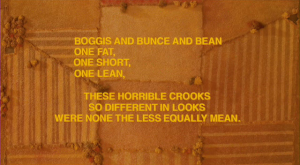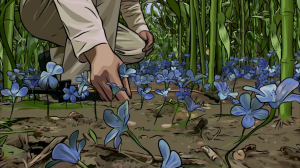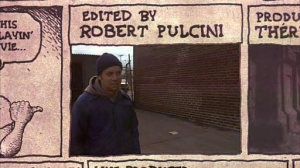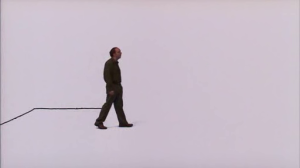Zaynah Quader
July 5, 2013
ENGL392B: English Literature on Film in the Twenty-first Century
Professor Joseph Byrne
Exploring the Imperialist Connection Between Austen’s Pride and Prejudice and Gurinder Chadha’s Film Adaptation
Jane Austen was born in 1775 in Hampshire, England to a “rural professional middle class” family. Although the Austen’s mingled with other gentry, they were also linked to the “larger world of fashionable society”, with familial connections to those in the upper class. Austen’s beginning works, which influenced the writing of her later novels, have elements of the burlesque. These elements included fitting large plots in smaller pages, contrasting people in different levels of society, using satire and parody. However, parody was generally considered a topic for male writers. Austen and her family were avid novel readers, and her works in particular seem to be heavily influenced by Frances Burney’s 1782 novel Cecilia. This novel has elements of “free indirect discourse,” a point of view style that Austen has come to be associated with. Free indirect discourse maintains an authoritative third person narration, but also understanding character’s internal feelings and thoughts. According to literary scholars, Jane Austen began writing as a form of entertainment for her family. Family is a major part of most of her works, especially in her 1813 novel Pride and Prejudice (Kelly).
Pride and Prejudice is Jane Austen’s second and most memorable novel. The story of the middle classed, headstrong Elizabeth Bennett finding and falling in love ad midst trials and tribulations with the genteel Mr. Darcy has been told and retold over again in various works including television, film and theater. Strong themes of the novel include family, manners and marriage. However, more modern scholars have interpreted the novel with an imperialist lens. Runjiang Xu and Yucheng Li, in a paper for The Canadian Centers for Science and Education close read the novel to reveal a surprising colonial subtext. Key notes on imperialism from the text include:
-
Domestic Exploitation: Bingley and Darcy’s exploration of Netherfield and surrounding land, which Bingley buys, is attributed to the Industrial Revolution. The Industrial Revolution was aided by colonial capitalism. The revolution led to increasing demand of labor force, which the rising bourgeoisie class hoped to satisfy with the Enclosure Movement, expelling farmers from their farmland in hopes to gain forces for labor in the industrialized cities.
-
Overseas Colonization: The authors draw parallels between Wickhams exploitation of Lydia and England’s exploitation of countries overseas. Wickham is a soldier, and during Austen’s lifetime, the only wars England waged were for American colonies and to compete with France in domination over Europe.
-
Austen’s Opinions of Colonialism: Austen highlights her complacent views on imperialism by ignoring it – even though there is considerable mention of soldiers, there is no talk of the politics of war, which at this time period, were revolved around colonization. Edward Said, in discussing Western literature and imperialism, said of Austen’s work, “improbable as art not involved with Empire” (Xu & Li).
Colonialism is apparent in Austen’s work, whether she wanted it to be or not. It is hard for a modern colonialist reviewer to separate English writing in Austen’s time period and England’s imperialism. This can be seen in the modern adaptation of her novel, the film Bride and Prejudice.
Director Gurinder Chadha is a Kenyan-born British Sikh of Indian descent. She is known for depicting British Indian culture, often depicting culture clash in films such as Bend it Like Beckham, The Mistress of Spice and It’s a Wonderful Afterlife. Her 2004 film Bride and Prejudice is a reinterpretation of Austen’s Pride and Prejudice, where Darcy is a wealthy hotel mogul on vacation in India, who meets the middle class Bakshi’s (Bennet’s) at a friends wedding. The film is often labeled “East meets West,” and this bringing together of the two hemispheres always invites colonial commentary. Lalita, the films reincarnation of Elizabeth, is unlike the character which she represents in one aspect: she is outspokenly anti-imperialist. After the American Darcy comments on how he prefers a Goan luxury hotel over the crowded cities of India, an angry Lalita says to him “I thought we got rid of imperialists like you!”
In fact, in Chadha’s adaptation, the conflict between Darcy and Elizabeth is more about their differing culture than their differing social class. While Darcy is wealthier than the Bakshi’s, its his way of ridiculing Indian culture (as well as influencing Bingley/Balraj to stop seeing her sister Jane/Jaya) that turns off Lalita. In comparison, Wickham, portrayed as a hippie-ish traveler, respects and loves Indian culture. Under a colonialism lens, Chadha’s film becomes confusing – Why does Lalita, who loves her culture, refuse Indian men for white American or British men? Balraj is British-Indian and respects Indian culture, but leaves Jaya in the dust. Darcy, by the end of the film, miraculously shows up with a dhol (drum) and, with no questions asked, Lalita and Darcy get married.
These questions become less confusing if the reason for Chadha’s adaptation is analyzed. According to Suchitra Mathur for M/C Journal, Indian Anglophones groaned upon hearing Chadha was trying to adapt Austen’s classic into a Bollywood “masala” film (masala is used to denote popular Bollywood films’ penchant for portraying a family friendly, something-for-everyone mix of genres, with music, dancing, romance, tragedy, comedy and action). Not only do these critics deride Bollywood films, but, according to Mathur, these critics viewed Pride and Prejudice as a “master text” while Bride and Prejudice was viewed as a silly “native” tribute. That is to say, Austen’s work is both canonical and transnational, while Chadha’s can only attempt to mimic the White Lady’s words.
While there are many Indian interpretations of English classics (recent Bollywood films have been made based on Othello, Macbeth and Emma), there is little to no interpretation of Indian classic literature for a Western audience. In recent years, strange fusions of literature and film from the subcontinent have been made into movies for the global screen. These include Michael Winterbottom’s adaptation of Tess of the D’urbervilles called Trishna set in Rajasthan with an all-Asian leading cast, Mira Nair’s adaptation of Mohsin Hamid’s The Reluctant Fundamentalist set in Pakistan and American and with American, Pakistani and British actors, Ang Lee’s Life of Pi and Deepa Mehta’s rendition of Midnight’s Children. Of course, many Bollywood films that have been made from classic Indian literature have been globally recognized, such as Sanjay Leela Bhansali’s Devdas. The only successful, global, film of recent years created from Indian literature for a Western audience is Danny Boyle’s Slumdog Millionaire. But even this is problematic – the novel the film was based on is not considered classic, canonical literature, and was not widely known, unlike Austen’s novel.
Countering these previous critics, Mathur believes that Chadha’s adaptation was ostentatious compared to the original and that this was done on purpose, calling the film “cheeky.” The entirety of the novel is set in England, but the film jet sets from Amritsar to Goa to LA and to London. Elizabeth and Darcy’s stroll through Pemberley is transformed into a chaotic musical number with water fountains, helicopters and choirs. Lydia’s hushed engagement is a fist fight between Wickham and Darcy in front of a projected movie, letting the audience know that indeed this is a movie, and indeed the director is having a little fun with the original text.
Chadha’s film is something important in the South Asian diaspora communities because it allows “postcolonial subversion” (Mathur). The film is a battle between master and native, and in the end, India wins. In the fight between Wickham and Darcy in the cinema, the film playing in the background is Manoj Kumar’s 1970 film Purab aur Paschim, translated, East and West. The fight does not culminate with Darcy getting one over Wickham, but instead with Wickham being slapped by two Indians, who do not need a white male savior by taking matters into their own hands (literally). Lalita is uncompromising and Darcy is shown at the end of the film decked out in Indian wedding clothes atop an elephant. If this happened in Austen’s novel, if the middle classed Bennet’s won the novel, Darcy would be seen at Longbourn, being treated to Mrs. Bennet’s nagging. In Austen’s novel it is assumed that Longbourn and the Bennet’s are saved by Bingley’s and Darcy’s added wealth, but this is understated in Chadha’s film. More widely, Chadha’s interpretation takes the same high class British culture that colonized India, swallowed one of it’s most beloved novels and belched out a cheesy, obnoxious, Bollywood masala film. Mathur says that authenticity was never Chadha’s goal, and, if the film is analyzed in this way, the director has created an intelligent (and entertaining) work of post colonial art.
Mathur also says that “the film thus becomes a classic instance of the colony “talking back” to the metropolis, of Caliban speaking to Prospero, not in the language Prospero has taught him, but in his own native tongue. The burden of responsibility is shifted; it is Prospero/audiences in the West that have the responsibility to understand the language of Bollywood without dismissing it as gibberish or attempting to domesticate it, to reduce it to the familiar.” Some Western audiences will not try to understand this film, which has been filmed in a very Bollywood context that refuses to explain itself to those unknowing. Chadha’s goal, however, is not to one up her fellow Brits, but to invite playful discourse between the East and West. Her ultimate goal, she says is to “make the Hindi language familiar to the world. After all, Bollywood is much bigger than Hollywood. Hopefully, it will work both ways. It will spur Westerners to watch more Hindi movies and also inspire Bollywood filmmakers towards better narratives” (Jha).
Works Cited
Jha, Subhash K. “Bride and Prejudice is not K3G.” Rediff.com. 30 August 2004. Web. June 10 2013. <http://inhome.rediff.com/movies/2004/aug/30finter.htm>.
Kelly, Garry. “Jane Austen.” Brandeis University. n.d. Web. 5 July 2013. <http://people.brandeis.edu/~teuber/austenbio.html>.
Mathur, Suchitra. “From British ‘Pride’ to Indian ‘Bride’.” M/C Journal (May 2007). Vol. 10, Issue 2. Web. 5 July 2013. <http://journal.media-culture.org.au/0705/06-mathur.php>.
Xu, Runjiang and Li, Yucheng. “Jane Austen and Imperialism — A Rereading of Pride & Prejudice.” The Canadian Centers for Science and Education. December 2009. Vol. 2, No.2. English Department, Zhenjiang Watercraft College of PLA. Web. 5 July 2013. <https://www.google.com/url?sa=t&rct=j&q=&esrc=s&source=web&cd=1&ved=0CCsQFjAA&url=http%3A%2F%2Fwww.ccsenet.org%2Fjournal%2Findex.php%2Felt%2Farticle%2Fdownload%2F4474%2F3819&ei=AFDWUbXNIMfW0QGCp4CwBg&usg=AFQjCNECYlEJwyqB9FywjKPcXE-XfTaotw&sig2=ncLYUrU_M0yKQs_x39gewQ>.
 4. Online Research on the Film
4. Online Research on the Film


 4. Online Research on the Film
4. Online Research on the Film

















